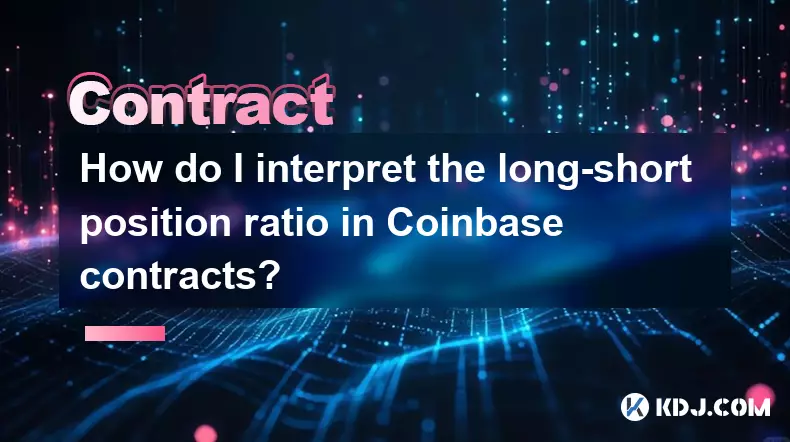-
 bitcoin
bitcoin $122090.672462 USD
1.59% -
 ethereum
ethereum $4493.758974 USD
0.56% -
 xrp
xrp $3.033145 USD
0.65% -
 tether
tether $1.000629 USD
0.00% -
 bnb
bnb $1169.854250 USD
7.07% -
 solana
solana $230.954786 USD
-0.19% -
 usd-coin
usd-coin $0.999785 USD
0.00% -
 dogecoin
dogecoin $0.256108 USD
-1.12% -
 tron
tron $0.342333 USD
-0.12% -
 cardano
cardano $0.859632 USD
-0.10% -
 hyperliquid
hyperliquid $48.932146 USD
-2.25% -
 chainlink
chainlink $22.345466 USD
-1.29% -
 ethena-usde
ethena-usde $1.000217 USD
-0.03% -
 avalanche
avalanche $31.203456 USD
1.93% -
 sui
sui $3.579145 USD
1.05%
How do I interpret the long-short position ratio in Coinbase contracts?
The long-short ratio on Coinbase reflects market sentiment by comparing long and short positions, with values above 1.0 signaling bullishness and below 1.0 indicating bearishness, but extreme levels may warn of impending reversals due to overleveraging.
Sep 20, 2025 at 08:55 pm

Understanding the Long-Short Position Ratio in Coinbase Contracts
The long-short position ratio is a key metric used by traders to gauge market sentiment on Coinbase and other cryptocurrency derivatives platforms. This ratio reflects the proportion of open long positions (bets that prices will rise) to short positions (bets that prices will fall). A balanced ratio typically hovers around 1.0, indicating equal bullish and bearish interest. Deviations from this equilibrium can signal shifts in trader behavior.
When analyzing this data, it's essential to consider both the direction and magnitude of the ratio. A value above 1.0 suggests more traders are holding long positions, potentially indicating optimism. Conversely, a ratio below 1.0 implies greater short-side exposure, often interpreted as bearish sentiment. However, extreme values may also point to overleveraged conditions that could precede reversals.
What Does a High Long-Short Ratio Indicate?
- A high long-short ratio, such as 1.5 or higher, shows that significantly more capital is committed to long positions.
- This condition often emerges during strong upward price momentum when traders chase gains.
- Elevated long dominance increases the risk of a short-term correction due to potential long liquidations.
- Market makers and algorithms may detect this imbalance and adjust pricing models accordingly.
- Historical patterns show that prolonged periods of high long ratios sometimes precede sharp pullbacks.
How Traders Use the Ratio for Tactical Decisions
- Scalpers monitor real-time changes in the ratio to identify sudden bursts of buying or selling pressure.
- Swing traders compare current levels against historical averages to assess whether the market is overextended.
- Some strategies involve fading extremes—taking contrarian positions when the ratio reaches multi-week highs or lows.
- Institutional participants integrate the ratio with order book depth and funding rates for confirmation.
- Automated trading bots use threshold-based triggers from the ratio to enter or exit positions.
Limitations and Risks of Relying Solely on the Ratio
- The ratio does not distinguish between retail and institutional positions, which can skew interpretation.
- Large whale accounts can distort the overall figure even if their activity represents a small number of trades.
- It fails to account for position size distribution; a few massive shorts can outweigh thousands of small longs.
- On Coinbase specifically, limited contract offerings compared to larger exchanges reduce data depth.
- Sudden news events can invalidate existing ratios before traders have time to react.
Frequently Asked Questions
Can the long-short ratio predict price movements accurately?While the ratio provides insight into market psychology, it is not a standalone predictor. Price action, volume, and macroeconomic factors must be analyzed alongside it to improve accuracy.
Where can I find the long-short ratio for Coinbase futures?Coinbase does not publish this data directly. Third-party analytics platforms aggregate open interest from available feeds and calculate the ratio using accessible API data.
Does a low ratio always mean a price drop is imminent?No. A low ratio indicates bearish positioning but does not guarantee further downside. Markets can remain oversold for extended periods, and unexpected catalysts may trigger short squeezes.
How frequently is the long-short ratio updated on tracking sites?Most services update the ratio every 5 to 15 minutes based on exchange-reported snapshots of open interest, though delays can occur during peak volatility.
Disclaimer:info@kdj.com
The information provided is not trading advice. kdj.com does not assume any responsibility for any investments made based on the information provided in this article. Cryptocurrencies are highly volatile and it is highly recommended that you invest with caution after thorough research!
If you believe that the content used on this website infringes your copyright, please contact us immediately (info@kdj.com) and we will delete it promptly.
- BlockDAG, DOGE, HYPE Sponsorship: Crypto Trends Shaping 2025
- 2025-10-01 00:25:13
- Deutsche Börse and Circle: A StableCoin Adoption Powerhouse in Europe
- 2025-10-01 00:25:13
- BlockDAG's Presale Buzz: Is It the Crypto to Watch in October 2025?
- 2025-10-01 00:30:13
- Bitcoin, Crypto, and IQ: When Genius Meets Digital Gold?
- 2025-10-01 00:30:13
- Stablecoins, American Innovation, and Wallet Tokens: The Next Frontier
- 2025-10-01 00:35:12
- NBU, Coins, and Crypto in Ukraine: A New Yorker's Take
- 2025-10-01 00:45:14
Related knowledge

What is the difference between futures and perpetual contracts for Bitcoin?
Oct 02,2025 at 11:54pm
Understanding Bitcoin Futures Contracts1. Bitcoin futures are derivative instruments that allow traders to speculate on the future price of Bitcoin at...

What is the best time to trade PEPE contracts?
Oct 03,2025 at 11:54am
Understanding PEPE Contract Volatility1. PEPE contracts exhibit extreme price fluctuations due to their meme-based nature and low market cap. Trading ...

What are the common mistakes to avoid with Bitcoincoin contracts?
Oct 03,2025 at 08:54am
Emerging Trends in the Cryptocurrency Market1. Decentralized finance (DeFi) platforms continue to expand their influence across the blockchain ecosyst...

What is the maintenance margin for Bitcoin contracts?
Oct 02,2025 at 01:36am
Decentralized Exchanges Gain Momentum in 20241. Decentralized exchanges (DEXs) have seen a significant rise in trading volume, surpassing centralized ...

How to use technical analysis for trading XRP contracts?
Oct 03,2025 at 01:18pm
Understanding Price Patterns in XRP Futures1. Identifying chart patterns such as triangles, head and shoulders, and double tops or bottoms can provide...

What does "longing" PEPE contracts mean?
Oct 03,2025 at 11:54pm
Understanding Decentralized Exchanges in the Crypto Ecosystem1. Decentralized exchanges (DEXs) operate without a central authority, allowing users to ...

What is the difference between futures and perpetual contracts for Bitcoin?
Oct 02,2025 at 11:54pm
Understanding Bitcoin Futures Contracts1. Bitcoin futures are derivative instruments that allow traders to speculate on the future price of Bitcoin at...

What is the best time to trade PEPE contracts?
Oct 03,2025 at 11:54am
Understanding PEPE Contract Volatility1. PEPE contracts exhibit extreme price fluctuations due to their meme-based nature and low market cap. Trading ...

What are the common mistakes to avoid with Bitcoincoin contracts?
Oct 03,2025 at 08:54am
Emerging Trends in the Cryptocurrency Market1. Decentralized finance (DeFi) platforms continue to expand their influence across the blockchain ecosyst...

What is the maintenance margin for Bitcoin contracts?
Oct 02,2025 at 01:36am
Decentralized Exchanges Gain Momentum in 20241. Decentralized exchanges (DEXs) have seen a significant rise in trading volume, surpassing centralized ...

How to use technical analysis for trading XRP contracts?
Oct 03,2025 at 01:18pm
Understanding Price Patterns in XRP Futures1. Identifying chart patterns such as triangles, head and shoulders, and double tops or bottoms can provide...

What does "longing" PEPE contracts mean?
Oct 03,2025 at 11:54pm
Understanding Decentralized Exchanges in the Crypto Ecosystem1. Decentralized exchanges (DEXs) operate without a central authority, allowing users to ...
See all articles










































































